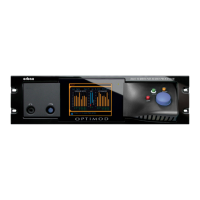OPTIMOD SURROUND PROCESSOR INSTALLATION
2-15
Each processing preset has a Dialnorm value that can override the global Dial-
norm values that you set in this step. To use the global Dialnorm value, be sure
that the active processing preset’s Dialnorm value is set to U
SE GLOBAL, which is
true of all Factory Presets except for the analog TV presets. In all cases, you must
ensure that the 8685’s active Dialnorm value matches the Dialnorm value you are
sending to consumers.
Setting the 8685’s active Dialnorm value:
A) L
OCATE to the Set Dialnorm screen (SYSTEM SETUP > QUICK SETUP 9).
B) Set the S
URROUND DIALNORM value so that it is the same as the Dialnorm value
you are transmitting to the consumer’s receiver.
Most broadcasting organizations have standardized on –24 or –25 dB.
Paragraph H.7 of ATSC Recommended Practice A/85:2009 recommends
–24 dB. (Strictly speaking, it recommends “–24 LKFS,” where LKFS is a
unit of measure for loudness when the ITU-R BS.1770 meter is used for
loudness measurement.)
If you are not driving a Dolby Digital system (in a netcasting application,
for example), you must choose an arbitrary value of Dialnorm. The 8685’s
processing was tuned for a nominal Dialnorm value of –19 dBfs and other
values of the 8685’s D
IALNORM control produce hidden offsets in the MB
LIMITER DRIVE and LOUDNESS THRESHOLD controls, as described above.
If you are not using the 8685 to process a Dolby Digital transmission, –19
dBfs is a reasonable choice for the 8685’s D
IALNORM. This splits the differ-
ence between the SMPTE standard line-up level (–20 dBfs) and the EBU
standard line-up level (–18 dBfs). It offers a good tradeoff between head-
room and noise, particularly in 16-bit transmission channels.
As you set Dialnorm closer to –11 dB, loudness increases. Eventually, you
will start to see significant limiter gain reduction as the 8685’s mastering-
quality look-ahead limiters work harder and harder prevent peak over-
load. Above a certain Dialnorm value, the limiters will start to create au-
dible side effects as they create more and more gain reduction. Allowing
up to 6 dB of limiter gain reduction is usually safe, but the best sounding
limiter gain reduction is no gain reduction at all, so we advise taking ad-
vantage of any available headroom in your transmission channel to
minimize the amount of look-ahead limiter gain reduction.
C) [Optional] Set the 2.0 DIALNORM value so that it is the same as the Dialnorm
value you are transmitting on your 2.0 channel stream, if any. This setting is
applied to all four 2.0 processors.
Conveying Metadata: All models of the 8685 can, via an SMPTE Rdd06-2008-
compliant RS-485 serial connection, automatically convey their active surround
metadata value to a downstream Dolby Digital encoder like the Dolby DP-569,
which must be set up according to its operating instructions to receive and act
upon this input. This greatly reduces the possibility that operator error will cause
the wrong value of surround metadata to be transmitted to consumers.
Units equipped with the optional HD-SDI module can also receive and send
metadata via the HD-SDI VANC data per SMPTE 2020-2-2008 (Method-A) or
SMPTE 2020-3-2008 (Method-B) and, if equipped with the optional Dolby-E

